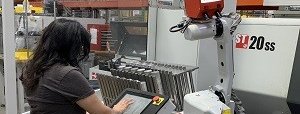
Mind the (Skills) Gap
Mind the (Skills) Gap
As technology advances and developments in science continue, a widespread fear has emerged internationally. What initially began as a trope in science fiction, television such as I, Robot and Westworld have helped create a worldwide belief that artificial intelligence will overpower humans and eventually pursue world domination. Although most people understand the absurdity behind the theory, a slightly more believable fear plagues many people. This fear is that robots are stealing jobs right out of the hands of working-class citizens. Automation of tasks, especially in the manufacturing field, has benefitted employers by allowing for efficient task completion and self-operating services with minimal, if any, need for human operation. The idea that this kind of automation is stealing jobs and resulting in higher unemployment rates, however, is far from accurate.
The U.S. Bureau of Labor Statistics (BLS) reported more job openings than people available to fill them. In the manufacturing sector, this finding can be attributed a phenomenon referred to as the skills gap, or the inability to find enough human workers to fill job openings. A recent study conducted by Deloitte and the Manufacturing Institute indicated that more than half of the 4.6 million manufacturing jobs created over the next ten years will go unfulfilled. Reasons for the inability to fill these positions are centered around the stigma behind manufacturing impacting younger generations, and the inevitable retirement of baby boomers. The study showed that although more than 80% of surveyed American believe the manufacturing industry is important in maintaining a strong economy, less than 30% would encourage their children to pursue a manufacturing career. The common misconceptions behind manufacturing, including lower pay and labor-intensive physical tasks in dirty and dim workspaces, leave numerous job opportunities largely unfulfilled. This is where robots come in.
The automation of tasks fills the open positions left by those who refuse to engage in the mundane side of manufacturing. PwC’s Global Artificial Intelligence Study suggests a potential contribution to the global economy of $15.7 trillion by 2030 from artificial intelligence, along with a boost in GDP for local economies of up to 26%. Along with these massive economic and labor productivity improvements, robots create significantly more employment opportunities for people with diverse skillsets, especially in urban areas. Some examples of positions include technicians, purchasing managers, safety managers, sales workers, operators, and programmers. Overall, the economic improvements made possible through the development of automation and artificial intelligence allow for wage increases and a much safer, productive environment. Although the extent of a robot’s capabilities are uncertain, it is clear that technological advancements in automation should be embraced – not feared.